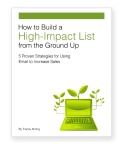Is your content hitting the right target?
Depending on the product or service you’re offering—and its complexity—your buying process could be either relatively simple or highly complex.
But as a B2B provider of clean technology solutions, chances are your sales process hangs out more on the complex end of the scale.
Even so, all your activities will probably tend to fall into three basic categories:
1. The education stage.
2. The solution stage.
3. The vendor stage.
And to complete a successful sale, the content you provide potential customers needs to be appropriate to each stage of this buying process.
Let’s look at each of these stages more closely.
The education stage
Prospects in the earliest stage of the buying cycle may be unaware they even have a problem that needs addressing.
Or they may be vaguely aware but not actively searching for a solution.
Whether they have a vague notion or none at all, they all share a similar lack of awareness.
So people at this stage need to be shown not only that a problem exists, but that not addressing it affects their business in critical ways.
They also need to know that you exist out there in the marketplace.
Types of content that work great to meet these needs include:
- Articles.
- Blog posts.
- Email.
- Microblogging (Twitter).
- Newsletters.
- Surveys.
- White papers.
Likewise, integrating your content—and striving for a consistent voice—will help your strategy come together as a much more powerful whole, no matter the method of consumption chosen by the buyer.
For example, let’s say a new prospect hears about you on Twitter or LinkedIn. Why not use these platforms to provide links to white papers, blog posts, or industry news?
The more ways you have of exposing prospects to your message, the greater your reach will be.
And remember to keep all content aimed at these early stage buyers focused on education—building awareness of a problem that affects their business and awareness of your company’s existence in the marketplace.
The solution stage
When your prospects move from learning about what’s out there to actually knowing they have a pain point that needs to be addressed, they’ve entered the active stage of the sales cycle.
This is the point where your content becomes less generalized and begins to specifically tackle your prospects’ needs and actively position your product or service as the solution.
Types of content that work well at this stage include:
- Case studies.
- Email.
- Microsites.
- Newsletters.
- Webinars.
- White papers.
The vendor stage
As we reach the final stage in the buying process, Sales becomes heavily involved, so all content should now be aimed at helping them close the deal.
Types of content needed at this stage include:
- Case studies.
- Competitive analysis sheets.
- Customer testimonials.
- ROI calculators.
- Spec sheets.
After all, your salespeople have one-on-one contact with your prospects and customers. So who better than they to know what really makes your prospects tick?
You may think you know what types of content your prospects need, but what you think and what your prospects want may be two totally different critters.
So talk to your sales staff. Ask for their input on your existing content. Does it have the right tone? Is it addressing the right issues? Is it transitioning to the next stage at the right point?
When Sales and Marketing are in alignment, your results can only get better.
Of course there’s no hard and fast rule for streamlining your buying stages, but I have outlined the basics for choosing the best content for each stage in the process.
And by using this as a guideline—and employing a little trial and error—you’ll find that any B2B product or service can be combined with appropriate content to create highly effective marketing campaigns.
Return to articles




